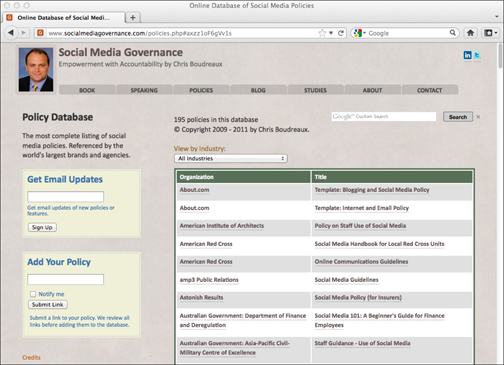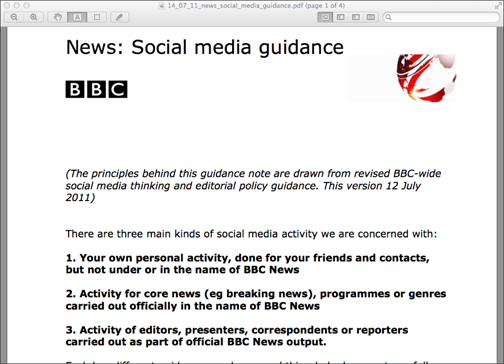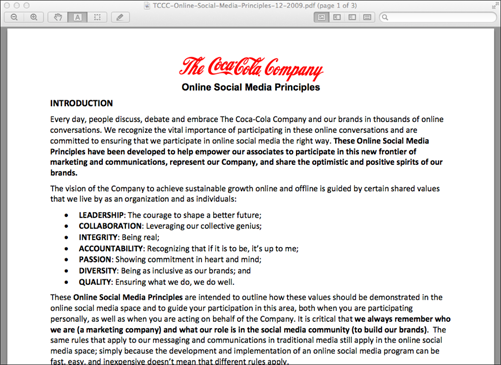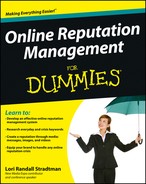Figure 4-3: Social Media Governance.
Creating Your Employee Online Reputation Policy
Some companies still believe they can get away with having an ad hoc sort of social media policy for their employees where they’re pretty laid back and only institute rules after there’s been a crisis resulting from an unfortunate recent event. These days, however, online conflagrations can escalate to dangerous levels within a couple of hours if gone unchecked and cause quite a stir within an organization, to say the least.
There are too many case studies out there already about major losses incurred by actual employees from the organizations that suffered the embarrassing social media frenzy. Here are a few examples of activity that unfortunately happen all the time and need a clear guideline before your organization’s online reputation management gets out of hand because of “friendly fire.”
![]() Rude commenting on the company’s profile by accident
Rude commenting on the company’s profile by accident
![]() Griping about management online
Griping about management online
![]() Gossiping about coworkers online
Gossiping about coworkers online
![]() Taking unauthorized office pictures and sharing them online
Taking unauthorized office pictures and sharing them online
![]() Posting negative rants (by disgruntled employees who still have access to company profiles)
Posting negative rants (by disgruntled employees who still have access to company profiles)
![]() Taking disturbing or foolish videos while at work and posting them online
Taking disturbing or foolish videos while at work and posting them online
Because many people in a given work population socialize online, you should get your crisis team together and create an employee online reputation policy that provides guidelines for behavior. This policy should
![]() Be realistic
Be realistic
![]() Be flexible
Be flexible
![]() Be able to accommodate new technologies or social network trends
Be able to accommodate new technologies or social network trends
![]() Not invade anybody’s individual privacy
Not invade anybody’s individual privacy
![]() Not compromise your organization’s privacy
Not compromise your organization’s privacy
![]() Give positive examples of what’s acceptable
Give positive examples of what’s acceptable
![]() Issuing a warning to offenders. This should be written, dated, and signed by the offender, acknowledging that she has been informed/warned.
Issuing a warning to offenders. This should be written, dated, and signed by the offender, acknowledging that she has been informed/warned.
![]() Dismissing employees who don’t comply.
Dismissing employees who don’t comply.
Modeling your process after others
Organizations often prefer to model their own behavior on that of their peers. Creating an employee online policy is no different. If your team would be more comfortable working this way, here are a few examples they can use:
![]() Social Media Governance: Database (see Figure 4-3) including more than 195 companies, includes
Social Media Governance: Database (see Figure 4-3) including more than 195 companies, includes
• Nonprofits
• Government agencies
![]() Dave Fleet: Database of policies to inspire and inform you
Dave Fleet: Database of policies to inspire and inform you
![]() Compliance Building: Database of policies to inspire and inform you
Compliance Building: Database of policies to inspire and inform you
![]() Toolkit Cafe: Sells a social media policies toolkit that can streamline your process
Toolkit Cafe: Sells a social media policies toolkit that can streamline your process
It’s interesting to note that many of these companies have a couple of different policies covering a range of online reputation management topics. For example, in Figure 4-3, About.com offers both a Template: Blogging and Social Media Policy and a Template: Internet and Email policy. You may find that you’re more comfortable devising separate strategies for your organization, depending on its size.
Always be positive and proactive. People always respond better to positive direction instead of a list of don’ts. (See Figure 4-5.)

Figure 4-4: BBC’s simplified social media guidance policy.

Putting a name on your policy
As you research and start developing your own approach to writing an employee social media policy for your organization, you’ll see all kinds of names that refer to basically the same thing, with some refinements. There is no codified system for naming your particular organization’s social media policy, though you can search for examples by using the following terms:
![]() Online social media principles
Online social media principles
![]() Social media guidance
Social media guidance
![]() Staff/volunteer presence on social networking sites
Staff/volunteer presence on social networking sites
![]() Facebook policy
Facebook policy
![]() Online community guidelines
Online community guidelines
![]() Using social media internally
Using social media internally
![]() Using social media to communicate with the public
Using social media to communicate with the public
![]() Internal postings policy
Internal postings policy
![]() Social media staff guidelines
Social media staff guidelines
Figure 4-5: The Coca-Cola Company calls attention to qualities it wants to see honored.

Implementing your new policy
Changes often take time to implement. Make sure that when you present your new policy to employees, you do so in a way that gives them time to read, digest, and adjust without feeling cornered or threatened. After all, your main focus is to avoid trouble, not to create resentments.
You will have the easiest time introducing this policy to your newly hired employees, who haven’t developed any routines or habits that will need to be broken. However, give existing employees at least 30 days to get used to the new policy, and be there to answer any questions. Be willing to refine your policy as good questions are asked that show where a point here or there may not be as clear as it looked when you were writing it at night while sipping something relaxing. Everybody gets to learn through this process together.
You even may have compelling internal issues brought to light and be able to act on them proactively, which is always preferable to waiting until they hit crisis mode.

